| Meaning
of Name |
Derives from the markings just behind the gill
plate, although this marking is observed to extend onto the plate itself.
This marking is supposed to display the letter 'A'.
|
| First
Description |
J.H.Huber 1998.
Aphyosemion alpha,
A New Species of the Subgenus Chromaphyosemion
with a Distinctive Colour Pattern and a Dead End Southern Distribution.
Das Aquarium, August, 1998 No.350 pp 15-23.
An English translation appears in BKA newsletter No.401, February 1999.
|
| Size |
Males 5-6cm, females 4-5cm.
|
| Meristics |
From Killidata - D = 12·33, A = 14, D/A
= -1, ll = 25·67
|
| Karyotype |
n = 19, A = 26
|
| Sub-Genus |
Chromaphyosemion
|
| Group |
|
| Synonyms |
- Aphyosemion splendopleure
(non Meinken
1930); Radda 1975.
- Aphyosemion
(Chromaphyosemion) sp. No.2 Legros
1990; Eberl 1996.
|
|
Populations
- Cap Estérias
- Cap Estérias - BDBG 04
/ 21
- Cap Estérias GACOCC 19
/ 70
- Cap Estérias GLP 06-01
- Cap Estérias LEC 93 /
26
- Cap Estérias LEC 93 /
24 - 17·1 km from Cap Estérias
- Cap Estérias BDBG 04-21
- Cap Estérias GLP 07
- Cap Estèrias-Santa Clara
GJS 00-34
- Cap Santa Clara (DNA 01)
- Mondah Forest GCCB 12
- Mondah Forest ACCC 13 / 508
- Nyonié GLC 14
- Owendo (area of southern Libreville)
- Santa Clara (GJS 00/34)
- G 02-95
- PK 16 / 3
- PK 18
- sp. No.2
|
DNA 01 - Cap Santa Clara
- Collected by Nevin Aspinwall in July-August 2001.
GJS 00 / 34 - Santa Clara - Material kindly
sent by Mogens Juhl "In the shady part of the stream we found A.striatum,
E.singa and more E.sexfasciatus
and a lot of other sp. and finally a female A.alpha.
We searched the stream quite a long way and suddenly came to a part
that was much wider and with a lot of plants in parts of the stream.
Although the plants were submerse they were not aquatic plants, just
plants that had been covered with water.
Here we found lots of A.alpha. Every
time lifting the foot from the plants one could immediately collect
some A.alpha in the footprint among
the plants. After a short time walking around these plants we had more
than enough of this species.
The most interesting about this population, despite it seems to be a
little more pretty than the earlier introduced populations with much
yellow to orange in the fins, it also seem to be a lot easier to reproduce.
The pH was very high, almost 7, which makes the demands for this population
much easier to fulfil.
Breeding this population one can easily get quite even numbers of males
and females, which is much different with the other populations that
often only gives males, or females, but not both.
Water temperature was 25°C, pH 6·85 and conductivity 54 microseimens".
Bill Drake in BKA newsletter No.439, April 2002
reported first 20 eggs turned out to be 10 males & 2 females. The
pH was lowered to 5 which gave an even sex ratio on the next batch of
young.
|
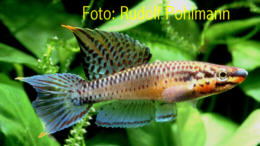
Santa Clara GJS 00/34
Wild male
Photo courtesy of Rudolf Polmann
|
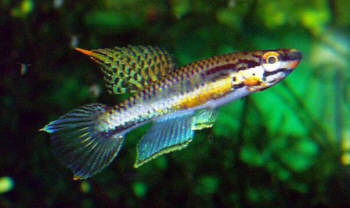
GJS 00 / 34. Photo
courtesy of Mogens Juhl
|
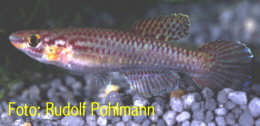
Santa Clara GJS 00/34
male
Photo courtesy of Rudolf Polmann
|
LEC 93/26 - Scroll down to see Breeding
report.
|
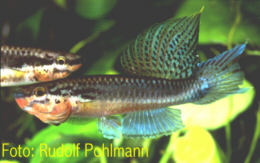
LEC 98 /26
male
Photo courtesy of Rudolf Polmann
|
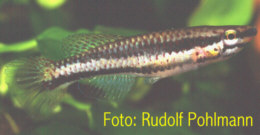
LEC 98 /26
female
Photo courtesy of Rudolf Polmann
|
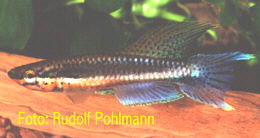
LEC 98 /26
male
Photo courtesy of Rudolf Polmann
|
sp. No.2 - Cap Estérias
|
| Type
Locality |
Holotype - 17·1 km north of Hotel Gamba
(Libreville airport) to Cap Estérias.Collection LEC 93 / 26.
Collected January 14th, 1993 by Legros, Eberl & Cerfontaine. Paratypes
collected in 1994 (PEG 94) at the same location.
|
| Distribution |
Fairly restricted to the Cap Estérias
& Cap Santa Clara areas.
|
| Habitat |
|

GJS 00 / 34.
Photo courtesy of Mogens Juhl.
|
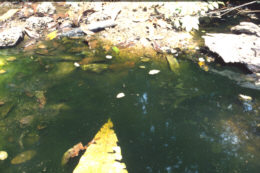
GJS 00 / 34.
Photo courtesy of Mogens Juhl.
|
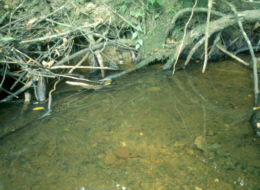
GJS 00 / 34.
Photo courtesy of Mogens Juhl.
|
|
|
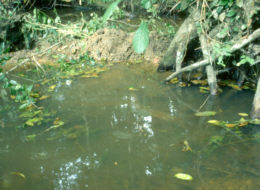
GJS 00 / 34.
Photo courtesy of Mogens Juhl.
|
|
It is worth noting that the above biotope photos
show water which is less brown & contains a high degree of algae.
Sympatric sp. include A.australe
& Ep.sexfasciatus.
Huber (Killidata) considers the habitat to be
coastal fringes which contain either little salt content or none at
all. Also mentioned is their being found in primary forest but on rare
instances in savannah biotopes.
Inhabits crystal clear running (slow) water in shady forested areas
over a sand or fine gravel base. Depth of water recorded at 30 cm. Water
temperature recorded at 22-32°C, acid water with low conductivity.
Eberl reported sympatric species - A.australe,
A.microphtalmum (escherichi),
A.striatum,E.sexfasciatus, E.singa, Procatopus
ngaensis. All found in slightly different subniches with
A.australe & A.striatum
found in warmer less clear biotopes over dead leaves. A.alpha
prefers the clearer water areas. Epiplatys
pefers margins while Procatopus
more central, deeper areas. Barbs & soft water shrimps also found.
On January 14th 1993 water temperature was 23°C, pH 5·7,
DH 0, electrical conductivity 25µs.
From the collection site 57 fry were taken back to captivity but all
grew on as males.
|
| Distinguishing
Characteristics |
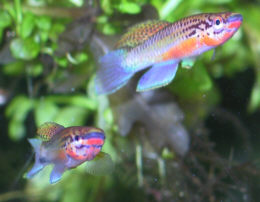 A.alpha males showing characteristic
red chin colouration. These are GJS 00 / 34.
A.alpha males showing characteristic
red chin colouration. These are GJS 00 / 34.
Photo courtesy of Mogens Juhl |
Strong blue colouration on body &
fins. The throat has an orange colour in males when spawning
or displaying. This can extend down the body as shown in the
photo.
Females can show markings in the throat
too to a lesser intensity.
|
|
| Colour/Pattern
Variability |
|
| History |
First discovered by Mersseman of Libreville in
1973 (possibly just before).
Huber visited Mersseman at the end of his 1976
collecting trip. At the time Merssemann had a fish called a 'blue form'
from 'inland'.
Collected in Gabon by Herzog & Bochtler in
1975. Legros considered it to have been collected also by Roman in Rio
Muni.
Collected by Ed Pürzl in 1985.
Collected by Buon, Mallet & Ragot in 1986.
Collected by Fourdrinier in 1988 16·3 km from Libreville airport
but the direction is not recorded in my reference material (Killidata).
Collected by Nümrich also in 1988.
Collected in 1993 at location LEC 93 / 26 by Legros, Eberl & Cerfontaine,
Gabon. First distributed
as Chromaphyosemion sp.
No.2. Collected by Wolfgang Eberl.
Collected in the same year by Passaro, Eberl & Guido who also collected
in 1994.
First entered the UK at a BKA lecture in Manchester - spring 1994 when
Wolfgang Eberl brought fish over for Bill Drake.
Described by Huber in August 1998. Article references to the first description
have been seen as 1999, but this is an error & probably refers to
a BKA translation of the original description.
Description was delayed due to difficulty in breeding
as they produced a strong sexual imbalance in favour of males. This
made experiments with hybridisation difficult.
Collected by Mogens Juhl et al. in 2000 from Santa
Clara.
|
| Breeding
Notes |
Bill Drake in BKA newsletter No.365, February
1996 writes a report on LEC 93/26. Fish were housed in a 12 x
12 x 9" tank. Fish started to lay after a few days of receiving
them but not many. He raised 14 fry & then lost the adult male.
This was replaced with a young male he had raised. Breeding resumed
in a few weeks but only 15 eggs a week.
At 72°F a few eggs were laid & then they stopped for weeks before
starting again. The same happened at 80°F.
In BKA newsletter No.401, February 1999 Bill
writes again to report keeping them in an 18 x 12 x 9" tank with
water at a temperature of 70-72°F, pH 6·9, 50% rain, 50%
tap water, conductivity 90-110µs. Only a few eggs were found in
Java moss & none in the mops. On water changing a good number of
eggs were found in the bottom dirt, some of which were eyed up.
The set up was changed with the addition of peat fibre to give a pH
of 5·5. Water temperature was 75-77°F due to the summer heat
& egg production dropped. The tank was moved to a cooler place &
the temperature went down to 68-70°F. Egg production immediately
increased.
From the first 10 fry he had 9 males & 1 female. With the lower
pH he got 8 males to 2 females but the temperature was 74-75°F.
A third batch with a lower pH gave 7 males & 3 females.
In 100% rainwater with peat fibre & Java moss with poor lighting
& 4 males to 6 females. Eggs were collected every 10 days &
the young sexed out to 2 males to every female. Only 1 pair in a 50%
rain/50% tapwater set up at 70-72°F with not much light produced
a 50/50 sex ratio some of the time & 6 males to 4 females at others.
If eggs are kept over 72°F the fry hatch with their yolk sac &
do not make good fish. It was found that the eggs need to be kept dark
or they will fungus. He found water used to store eggs should by pH
4. After hatching the water was slowly changed to bring the pH up to
about 6·5. Out of 10 eggs, 5 hatched & turned into 3 females
& 2 males. Next 10 eggs tried resulted in 4 females, 2 males &
the next 10 eggs turned into 3 females & 1 male. The last 10 eggs
resulted in 5 females.
Production of eggs is low. If 30 eggs are collected in a month only
8 will grow to make young fish. Fry are not fast growers. They will
take newly hatched brine shrimp as a first food. It took 12 months to
reach full size. Older fish (2 years +) were found to produce less eggs
but more hatched out.
Young fish are reported (Killidata) to take 8
weeks to sex out & take 6 months to reach maturity.
Legros reported egg production low. Eggs collected
from floating & bottom mops which were larger than A.bitaeniatum.
Water incubation at 21°C takes 2-3 weeks. Better egg production
can be had with pH 4·5 - 5. Below pH 4 eggs fungus & fish
frequently come down with velvet.
Fry take newly hatched brine shrimp. Growth is slow.
|
| Diameter
of Egg |
1·3
mm |
| Remarks |
Males can be aggressive which makes the species
more difficult to maintain. Legros found the 1988 collection (Fourdrinier?)
was more difficult to maintain than the LEC 93 / 26 collection.
Many aquarists breeding this species have reported sex ratio heavily
in favour of males however Cerfontaine reported getting nearly 100%
females.
|










